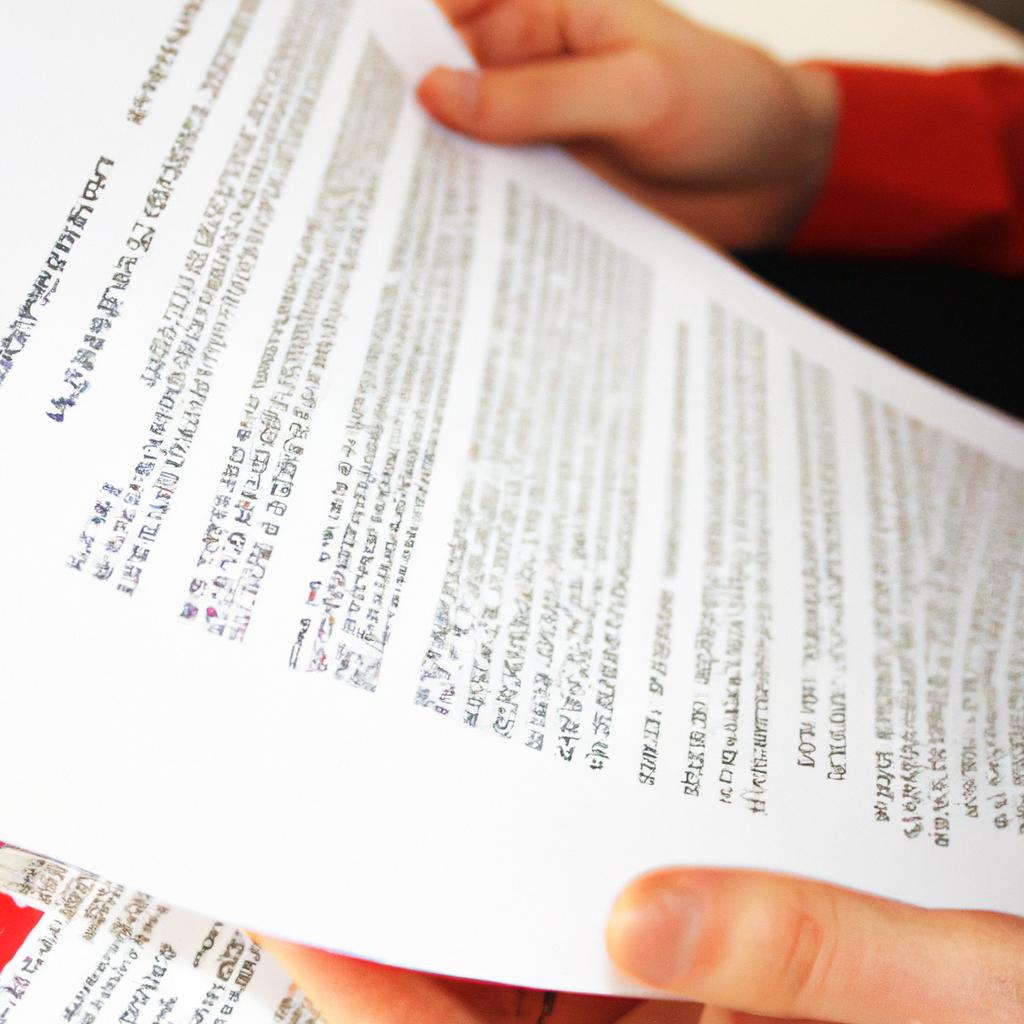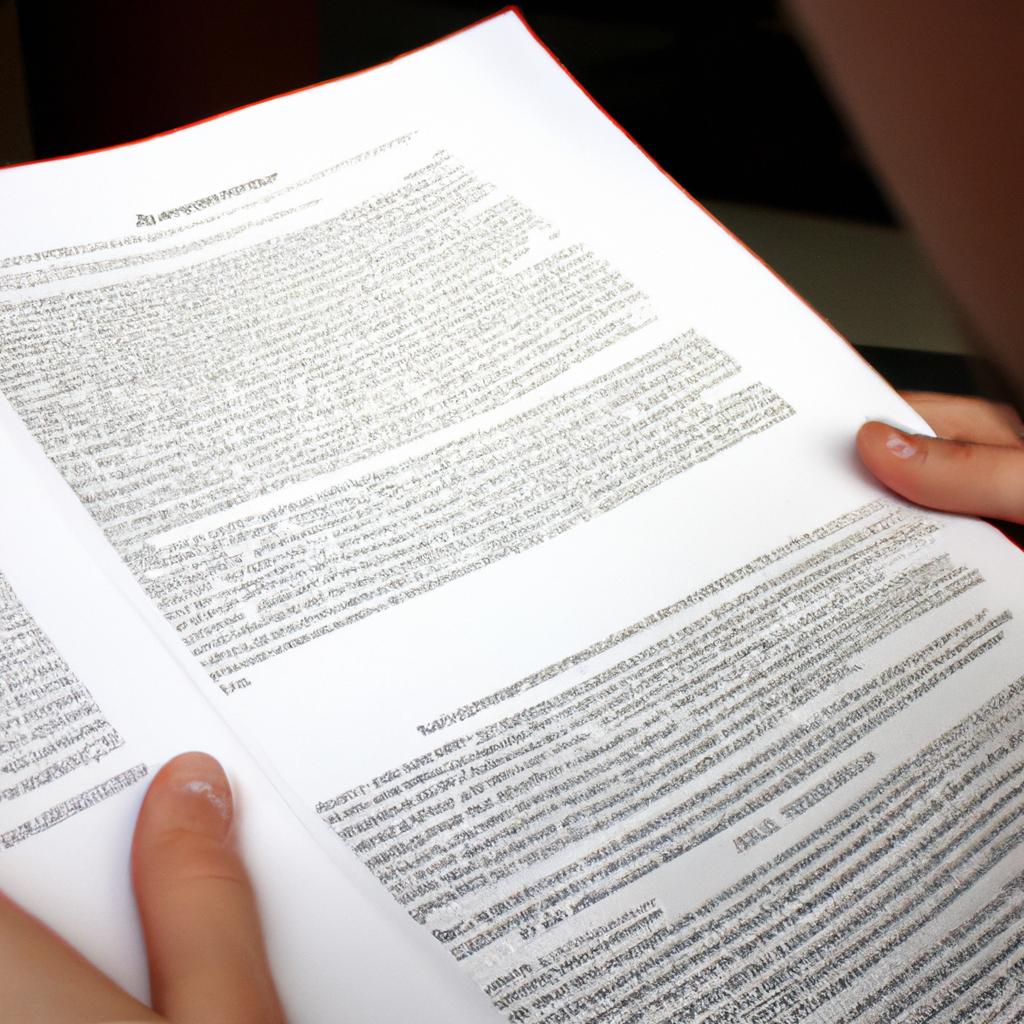Effective contract drafting is a crucial skill for lawyers working in law firms. It requires careful attention to detail, precision in language, and an understanding of legal principles. In this article, we will explore the key elements of effective contract drafting and provide practical guidance for law firm lawyers.
To illustrate the importance of effective contract drafting, let us consider a hypothetical scenario involving two parties entering into a business agreement. Without a well-drafted contract that clearly defines each party’s rights and obligations, disputes may arise later on due to ambiguities or gaps in the document. For instance, if Party A agrees to deliver goods to Party B but fails to specify any deadline or delivery terms, Party B might experience delays or difficulties in receiving the goods as expected. This could lead to frustration and potential litigation between the parties.
In light of such scenarios, it becomes evident why mastering the art of effective contract drafting is paramount for law firm lawyers. By crafting contracts that are clear, comprehensive, and unambiguous, attorneys can minimize their clients’ risks while promoting smoother business transactions. The following sections will delve into various aspects of contract drafting techniques and offer practical tips for ensuring high-quality contractual agreements within the context of law firms.
Understanding the Legal Framework
To effectively draft contracts, it is essential for law firm lawyers to have a thorough understanding of the legal framework that governs contract formation and enforcement. This section will provide an overview of key concepts and principles in contract law, equipping readers with the necessary foundation to navigate through the complexities of contract drafting.
One example that illustrates the importance of understanding the legal framework involves a hypothetical scenario where Company A enters into a contract with Company B for the sale of goods. However, due to ambiguous language used in the contract, disputes arise regarding payment terms and delivery obligations. In such cases, a clear understanding of contractual interpretation rules becomes crucial in determining each party’s rights and responsibilities.
The legal framework governing contracts encompasses several fundamental elements:
- Offer and Acceptance: Contracts are formed when one party makes an offer and another party accepts it without any modifications or conditions. The objective theory of contracts dictates that agreements should be interpreted based on what a reasonable person would understand from their words and actions.
- Consideration: For a contract to be valid, there must be mutual exchange or consideration between parties involved. Consideration can take various forms, including money, goods, services, or promises thereof.
- Intention to Create Legal Relations: Parties entering into a contract must intend for it to create legally binding obligations upon them. While social agreements may not have this intention, commercial transactions generally do.
- Capacity and Legality: To form a legally enforceable agreement, both parties must possess sufficient capacity (mental competence) to understand the nature and consequences of their actions. Additionally, contracts entered into for illegal purposes or contrary to public policy are considered void ab initio.
Embracing these foundational principles allows law firm lawyers to approach contract drafting with clarity and precision. By adhering closely to these guidelines throughout each stage of the process—including negotiation, drafting provisions, reviewing edits—lawyers ensure that their clients’ interests are protected and that the resulting contract is legally sound.
In transitioning to the subsequent section on “Identifying Key Contract Provisions,” it becomes evident how a strong grasp of the legal framework assists lawyers in identifying crucial elements that should be included within a well-drafted contract.
Identifying Key Contract Provisions
Transitioning seamlessly from our exploration of the legal framework, let us now delve into identifying key contract provisions. To illustrate this concept, consider a hypothetical scenario involving two parties entering into a business agreement for the sale of goods. The seller agrees to deliver the specified products within a certain timeframe, while the buyer commits to making timely payments upon receipt. This example highlights the significance of clear and enforceable clauses in contracts.
When drafting effective contracts, it is crucial to identify and address key provisions that serve as pillars supporting successful agreements. These provisions not only ensure clarity but also protect the interests of all parties involved. Here are some essential elements to consider:
- Scope and objectives: Clearly define the purpose and scope of the agreement, outlining each party’s roles and responsibilities.
- Terms and conditions: Establish specific terms pertaining to price, payment schedules, delivery timelines, quality standards, warranties, indemnification clauses, dispute resolution mechanisms, etc.
- Confidentiality and non-disclosure obligations: In cases where sensitive information is shared between parties during contractual engagements or partnerships, confidentiality clauses play a vital role in safeguarding proprietary knowledge or trade secrets.
- Termination and remedies: Specify circumstances under which either party can terminate the agreement without breaching its terms. Additionally, outline appropriate remedies or penalties for any breach committed by either party.
To better comprehend these critical contract provisions visually, refer to the following table:
| Provision | Purpose | Example |
|---|---|---|
| Scope | Defines what falls within the agreement | Products sold |
| Payment Schedule | Specifies when payments should be made | Timely payment |
| Delivery Timeline | Outlines when goods should be delivered | Specified timeframe |
| Dispute Resolution | Provides mechanism for resolving conflicts | Arbitration or mediation |
By carefully considering these important aspects during contract drafting processes, lawyers can ensure that agreements are comprehensive, balanced, and legally enforceable. In doing so, both parties can rely on clear provisions to guide their interactions throughout the duration of the agreement.
Transitioning smoothly into the subsequent section about “Drafting Clear and Precise Language,” it is essential to pay careful attention to language choices when crafting contractual clauses. By employing precise wording and eliminating any ambiguity, lawyers can further strengthen the legal efficacy of contracts.
Drafting Clear and Precise Language
Having identified key contract provisions, the next step in effective contract drafting is ensuring that these provisions are articulated clearly and precisely. This ensures that both parties have a mutual understanding of their rights, obligations, and responsibilities under the contract. By using language that leaves little room for interpretation or ambiguity, potential disputes can be minimized.
Paragraph 1:
For instance, consider a hypothetical scenario where two companies enter into a distribution agreement for a new product launch. The contract includes a provision specifying the territories within which each party has exclusive sales rights. However, if this provision is drafted vaguely without clear geographic boundaries indicated, it could lead to disagreements regarding overlapping territories or confusion about where each party’s exclusivity begins and ends. Therefore, it is crucial to draft such provisions with precision by explicitly defining the scope and limitations of territorial rights.
Emotional bullet point list:
- Avoiding misunderstandings between contracting parties
- Reducing costly legal disputes
- Enhancing contractual clarity and enforceability
- Establishing trust and confidence in business relationships
Paragraph 2:
To achieve clear and precise language in contracts, certain strategies can be employed:
| Strategies for Drafting Clear and Precise Language |
|---|
| Use defined terms consistently throughout the contract |
| Eliminate unnecessary jargon or complex language |
| Break down lengthy sentences into shorter ones |
| Clearly outline conditions precedent or subsequent |
These strategies enhance readability while minimizing any chance of misinterpretation or confusion among the parties involved.
Paragraph 3:
By employing these techniques, lawyers can effectively communicate their clients’ intentions while reducing potential risks associated with vague or ambiguous contract language. Ensuring clear and precise language not only strengthens the overall quality of a contract but also fosters an environment of transparency and efficiency in business transactions. In doing so, both parties can move forward confidently knowing that expectations have been clearly articulated and agreed upon.
With clear and precise language established, it is essential to focus on ensuring consistency and cohesion throughout the contract. This ensures that all provisions align harmoniously with each other, creating a comprehensive and cohesive document.
Ensuring Consistency and Cohesion
Transitioning seamlessly from the importance of clear and precise language in contract drafting, it is equally crucial to ensure consistency and cohesion throughout the entire document. By maintaining a consistent tone, structure, and terminology, lawyers can create contracts that are easier to understand, interpret, and enforce. To illustrate this point, let’s consider a hypothetical scenario involving two parties entering into a lease agreement for commercial property.
In this case study, Party A is leasing office space to Party B for a five-year term. Throughout the contract, Party A refers to itself as “the Lessor,” while Party B is consistently referred to as “the Lessee.” The terms used remain consistent not only within each provision but also across different sections of the contract. This uniformity helps prevent confusion or ambiguity regarding the roles and obligations of both parties.
To achieve consistency and cohesion in contract drafting effectively, lawyers should keep in mind several key considerations:
- Use standardized language: Utilize established legal terminology and standard clauses commonly employed in similar types of contracts.
- Maintain parallelism: Ensure parallel structure within lists or provisions so that each item follows the same grammatical pattern.
- Adopt a logical flow: Organize provisions in a coherent manner that guides readers through the contract logically.
- Implement cross-references: When necessary, refer back to other sections or definitions within the document using precise references.
By adhering to these principles of consistency and cohesion, lawyers can enhance clarity and readability while minimizing potential misunderstandings or disputes between contracting parties.
| Key Considerations |
|---|
| Standardized Language |
| Parallel Structure |
| Logical Flow |
| Cross-References |
Remembering our goal of creating effective contracts that leave no room for misinterpretation or misunderstanding, we now turn our attention towards addressing potential ambiguities.
Addressing Potential Ambiguities
Section H2: Ensuring Consistency and Cohesion
[Transition from previous section]To ensure that contracts are not only legally sound but also effective in achieving their intended purposes, it is crucial to address potential ambiguities. Ambiguities can arise due to imprecise language or inadequate drafting techniques, leading to confusion and disputes between parties involved. In this section, we will explore strategies for identifying and addressing these potential ambiguities.
One common scenario where ambiguity may emerge involves the use of vague terms such as “reasonable time” or “best efforts.” For instance, consider a contract between a software company and its client, which includes a clause stating that the company must deliver updates within a reasonable time frame. The lack of specific guidelines regarding what constitutes a reasonable timeframe could lead to disagreements if one party expects immediate updates while the other deems three months as acceptable. To mitigate such risks, lawyers should employ clear and precise language when defining contractual obligations.
When drafting contracts, legal professionals should pay close attention to inconsistent provisions throughout the document. These inconsistencies can occur unintentionally during multiple rounds of revisions or when different individuals contribute to various sections without proper coordination. To maintain cohesion and clarity, it is advisable to create checklists or style guides encompassing standard terminology and formatting guidelines. By adhering to these consistent standards, lawyers can minimize discrepancies and enhance overall comprehension.
Addressing potential ambiguities requires meticulous attention to detail at every stage of contract drafting. Here are some recommended practices:
- Use defined terms consistently throughout the agreement.
- Clearly specify performance metrics and criteria.
- Provide explicit instructions on how unforeseen circumstances should be handled.
- Include dispute resolution mechanisms such as mediation or arbitration clauses.
By following these best practices, legal practitioners can help foster harmonious business relationships by reducing misunderstandings that may otherwise escalate into costly litigation battles.
| Best Practices | Description |
|---|---|
| Use Defined Terms Consistently | Consistent use of defined terms reduces confusion and ensures clarity. |
| Specify Performance Metrics | Clearly defining performance metrics helps set expectations for all parties involved. |
| Addressing Unforeseen Circumstances | Including provisions on how unforeseen circumstances should be handled minimizes disputes. |
| Dispute Resolution Mechanisms | Incorporating dispute resolution mechanisms provides a structured process for resolving conflicts. |
In summary, mitigating potential ambiguities is essential in effective contract drafting to prevent misunderstandings and costly legal disputes. Lawyers must utilize precise language, maintain consistency throughout the document, and address uncertainties explicitly. By employing these strategies, attorneys can create contracts that are clear, unambiguous, and conducive to successful business relationships.
[Transition to subsequent section: Reviewing and Revising for Accuracy]Reviewing and Revising for Accuracy
To ensure the clarity and effectiveness of a contract, it is crucial for lawyers to address potential ambiguities that may arise during the drafting process. By anticipating these ambiguities and proactively resolving them, legal professionals can minimize the risk of misinterpretation or disputes down the line.
One example illustrating the importance of addressing potential ambiguities involves a real estate contract. Suppose a buyer agrees to purchase a property “as-is” without any specific provisions regarding repairs or defects. However, if there are undisclosed structural issues discovered after closing, both parties might have different interpretations on who bears responsibility for fixing them. To avoid such ambiguity, an attorney could include explicit language in the contract stating whether the seller guarantees the absence of any latent defects.
When addressing potential ambiguities, there are several key considerations that lawyers should keep in mind:
- Clear definitions: Clearly define all relevant terms used throughout the contract to eliminate any confusion about their intended meaning.
- Unambiguous language: Use clear and concise language to convey each provision’s intent without room for multiple interpretations.
- Anticipate future scenarios: Consider various possible situations that may occur over time and draft provisions accordingly to cover those eventualities.
- Consistency: Ensure consistency within the document by using consistent terminology, grammar, structure, and formatting.
| Key Considerations | Examples |
|---|---|
| Clear Definitions | – Defining “confidential information” as any data shared between parties marked as confidential – Defining “due diligence period” as a specified number of days given to one party for inspection purposes |
| Unambiguous Language | – Using active voice instead of passive voice in contractual clauses – Avoiding overly complex sentence structures |
| Anticipating Future Scenarios | – Including termination clauses with clearly defined circumstances under which either party can terminate the agreement – Accounting for changing regulations or laws that may affect the contract’s validity |
| Consistency | – Maintaining consistent numbering or lettering for clauses and subclauses – Ensuring uniformity in font styles, sizes, and formatting throughout the document |
By diligently addressing potential ambiguities through clear definitions, unambiguous language usage, anticipation of future scenarios, and maintaining consistency within the contract, lawyers can significantly enhance its clarity and effectiveness. This proactive approach not only minimizes the risk of misinterpretation but also helps build trust between parties involved.
Remember that effective contract drafting requires a comprehensive review to ensure accuracy. The following section will delve into essential techniques for reviewing and revising contracts to further refine their quality and reduce any remaining uncertainties.
 Cowley Law Offices LLC
Cowley Law Offices LLC



